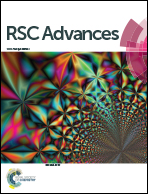A dendrimer matrix for performance enhancement of evanescent wave absorption-based fiber-optic biosensors†
Abstract
Dendrimers are monodispersed, hyperbranched macromolecules which have a globular shape and high pendant group density. Due to these unique properties, dendrimers have been used for catalytic, biochemical, pharmaceutical, biomedical and energy transfer applications. This study demonstrates the potential of a dendrimeric biointerface for the immobilization of bioreceptors, and the overall improvement of the performance of evanescent wave absorbance-based fiber-optic biosensors. Amine functionalized sensor substrates obtained by fourth generation poly(amidoamine) dendrimer immobilization were compared with substrates obtained by a conventional silanization technique that used aminopropyl triethoxysilane. A fluorescein isothiocyanate-based amine assay and X-ray photoelectron spectroscopy showed that the dendrimer matrix had 2.4 times the number of amine groups of the silanized surface. Further, atomic force microscopy-based topographic analysis revealed that the dendrimer matrix caused a 1.3-fold increase in surface area compared to the silane matrix, which caused a negligible change. In addition to a two-fold improvement in antibody loading compared to conventionally functionalized probes, an eight-fold increase in the sensor response for critically important lower concentrations of analyte was observed with dendrimer coated U-bent fiber-optic probes. Our detailed experimental studies demonstrated the potential of the dendrimer for preparing a biosensing platform with high protein loading, amplified sensor response and low nonspecific protein binding.


 Please wait while we load your content...
Please wait while we load your content...